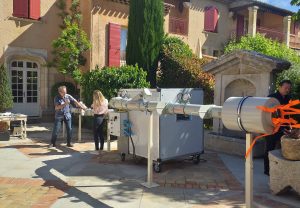Here’s an aspect of energy saving in motor-driven systems that had never occurred to me until I went on a training course about industrial dust extraction systems. Our instructor, Christoph Ritter of Osprey Corporation (pictured on the training rig), guaranteed his audience that if he went to their factories he would find that some of their vacuum fans would be running backwards This may sound crazy, but it can and does happen. It only needs two of the motor power connections to be swapped accidentally. Centrifugal fans do still work in reverse but their efficiency becomes diabolical. If they have straight radial blades the fan-wheel itself is no less efficient but the air leaving the volute has to turn through 180 degrees, with the consequent loss of head. If the fan has backward-curved blades (normally more efficient) these are forward-curved when reversed, introducing even more loss.
The problem tends to be masked in direct-coupled fans with variable-frequency drives. One reason is that you cannot easily see the direction of rotation when there are no belts to observe; the other is that the drive system will compensate by speeding up the fan (if it can) drawing much more power to deliver the required air flow. On Christoph’s course he uses a rig to demonstrate this and a fan current of 5 amps had to go up to 22 amps to deliver the same flow when the fan motor was running backwards.
Don’t assume it cannot happen to you.
